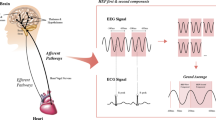Abstract
In order to study the relationship between visual fatigue and respiratory characteristic parameters caused by 3D display, 30 subjects were invited to watch 3D videos for 90 min. A questionnaire survey was performed in the initial state and every 15 min after watching the video to obtain the subjective data, and 7 groups of data were collected. The characteristic parameters of breathing were acquired synchronously using breathing sensors. The data was analyzed using SPSS. The results show that subjective fatigue increases with the increase of time spent watching 3D videos, and subjective visual fatigue increases extremely significantly from 45 to 60 min. The mean of power, index of the respiratory frequency domain, and the corresponding standard deviation show a highly significant linear negative correlation with time and the consistency with subjective fatigue score reached 0.970, indicating that the power value is effective for visual fatigue assessment. Therefore, based on the power mean or standard deviation of the breathing signal, the time is used to estimate or evaluate the time of watching 3D display.
Access this chapter
Tax calculation will be finalised at checkout
Purchases are for personal use only
Similar content being viewed by others
References
Wang YJ, Gao XL, Shi HM, Zhang YL, Wang Q, Bai Y (2016) Influence of polarized 3D displayer on visual function. J Tianjin Med Univ 22(04):328–331
Yano S, Emoto M, Mitsuhashi T (2004) Two factors in visual fatigue caused by stereoscopic HDTV images. Displays 25(4):141–150
Kooi FL, Toet A (2004) Visual comfort of binocular and 3D displays. Displays 25(2–3):99–108
Matsuura Y (2019) Aftereffect of stereoscopic viewing on human body II. In: Stereopsis and hygiene. Springer, Singapore, pp 89–99
Alhaag MH, Ramadan MZ (2017) Using electromyography responses to investigate the effects of the display type, viewing distance, and viewing time on visual fatigue. Displays 49:51–58
Lambooij M, Fortuin M, Heynderickx I, IJsselsteijn W (2009) Visual discomfort and visual fatigue of stereoscopic displays: a review. J Imag Sci Technol 53(3):30201-1
Li HCO, Seo J, Kham K, Lee S (2008) Measurement of 3D visual fatigue using event-related potential (ERP): 3D oddball paradigm. In: 2008 3DTV conference: the true vision-capture, transmission and display of 3D video. IEEE, pp 213–216
Tam WJ, Speranza F, Yano S, Shimono K, Ono H (2011) Stereoscopic 3D-TV: visual comfort. IEEE Trans Broadcast 57(2):335–346
Park MC, Mun S (2015) Overview of measurement methods for factors affecting the human visual system in 3D displays. J Display Technol 11(11):877–888
Kim CJ, Park S, Won MJ, Whang M, Lee EC (2013) Autonomic nervous system responses can reveal visual fatigue induced by 3D displays. Sensors 13(10):13054–13062
Mehler B (2015) Recording heart rate & electrodermal activity as measures of cognitive load in the driving environment. https://doi.org/10.13140/RG.2.1.2050.6329
Aryal A, Ghahramani A, Becerik-Gerber B (2017) Monitoring fatigue in construction workers using physiological measurements. Autom Constr 82:154–165
Yuhong Z, Haiping L, Fusheng Z, Mantian LI, Wei G, Pengfei W (2014) Real-time monitoring system for driver’s fatigue states based on respiratory signal. J Jiangnan Univ (Nat Sci Ed) 13(01):55–59
Yu Q (2018) The design and implementation of the mobile terminal heart rate analysis engine based on photo-plethysmograph imaging technology. Master Thesis of Beijing University of Posts and Telecommunications, Beijing University of Posts and Telecommunications, Beijing
Xu S (2012) The study on the discriminating method of driving fatigue based on physiological signal. Master Thesis of Beijing University of Technology. Beijing University of Technology, Beijing
Ye CW (2018). Research on automobile driving fatigue based on ECG signal and EMG signal (Doctoral dissertation). Master Thesis of Hefei University of Technology, Hefei University of Technology, Hefei
Fu RR, Tian YS, Wang SC, Wang L (2019) The recognition of driver's fatigue based on dynamic Bayesian estimation. Chin J Biomed Eng 38(06):759–763
Acknowledgements
This work is supported by National Key R&D Program of China (2017YFF0206604) and General Project of China University of Labor Relations (20XYJS020).
Author information
Authors and Affiliations
Corresponding author
Editor information
Editors and Affiliations
Ethics declarations
The study was approved by the Logistics Department for Civilian Ethics Committee of China University of Labor Relations.
All subjects who participated in the experiment were provided with and signed an informed consent form.
All relevant ethical safeguards have been met with regard to subject protection.
Rights and permissions
Copyright information
© 2020 The Editor(s) (if applicable) and The Author(s), under exclusive license to Springer Nature Singapore Pte Ltd.
About this paper
Cite this paper
Sun, G. (2020). Research on Respiratory Signals for Visual Fatigue Caused by 3D Display. In: Long, S., Dhillon, B.S. (eds) Man-Machine-Environment System Engineering. MMESE 2020. Lecture Notes in Electrical Engineering, vol 645. Springer, Singapore. https://doi.org/10.1007/978-981-15-6978-4_76
Download citation
DOI: https://doi.org/10.1007/978-981-15-6978-4_76
Published:
Publisher Name: Springer, Singapore
Print ISBN: 978-981-15-6977-7
Online ISBN: 978-981-15-6978-4
eBook Packages: Computer ScienceComputer Science (R0)




